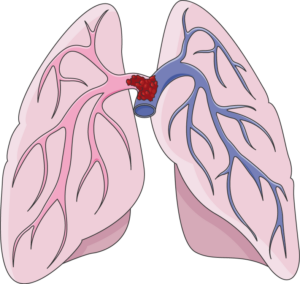Have you noticed a yellow bruise behind a knee and are worried this could mean a blood clot, either in that location or nearby?
A blood clot in a deep vein is called a deep vein thrombosis.
This is a very serious condition, even if you don’t feel any pain.
A fragment of a DVT, or the whole thing, can dislodge from the vein and, in just moments, travel to the lungs and block airflow.
If the clot is big enough, it can become trapped at the point where the pulmonary arteries branch off into each lung: a “saddle” pulmonary embolism, obstructing oxygenated blood from entering the lungs; death can result very quickly.

Saddle pulmonary embolism. Laboratoires Servier, CC BY-SA /creativecommons.org
It’s only natural, then, to worry about blood clots when you discover what seems to be a sign.
Yellow Bruising Behind a Knee: Blood Clot?
“A bruise is yellow because it is a resolving bruise, and as the bruise heals, your body creates compounds called biliverdin and bilirubin, which are pigments resulting from the breakdown of hemoglobin,” explains Dr. Lawrence Presant, DO, chief medical officer with Arizona Vein Specialists.
“These compounds cause the bruise to turn yellow.
“A bruise behind your knee is most likely not a blood clot — and it is certainly not a deep vein blood clot, since you would need an ultrasound to detect a deep vein blood clot.
“And if you have one, it is probably not a deep vein blood clot.
“A surface vein blood clot would not look like a yellow bruise — but more like a blue and purple lump.”
The area may be tender (even painful) and also reddish. It may feel like a cord to your fingertips and may also feel warm to the touch.
So where did the bruise behind your knee come from in the first place?
It came from the same source that any other yellowing (healing) bruise on your body would typically come from: a bumping into something or getting struck there.
Since the bruise behind your knee is already yellow, the offending incident is probably too long ago for you to recall, if it had not caused much pain at the time.
Are surface blood clots dangerous?
A surface blood clot is also known as superficial thrombophlebitis. This is not a serious condition and should not be equated with the DVT.
Surface clots often resolve on their own within a few to several weeks, and may be very uncomfortable – but they rarely, if ever, break off and travel to your lungs.
Though superficial thrombophlebitis can be associated with a higher likelihood of a concurrent DVT, the condition, in and of itself, is typically nothing more than a temporary nuisance and short-lived discomfort, requiring only home treatment.
If you have one, don’t worry; just follow your doctor’s instructions.
With all of this said, you can be rest assured that a yellow bruise – anywhere on your body, for that matter – is not a deep blood clot or even a superficial one.
 Dr. Lawrence Presant, DO, is chief medical officer at Arizona Vein Specialists in Phoenix, and a certified diplomat of the American Board of Venous and Lymphatic Medicine. A vein surgeon specialist, his passion is phlebology, the diagnosis and treatment of painful and unsightly vein disorders.
Dr. Lawrence Presant, DO, is chief medical officer at Arizona Vein Specialists in Phoenix, and a certified diplomat of the American Board of Venous and Lymphatic Medicine. A vein surgeon specialist, his passion is phlebology, the diagnosis and treatment of painful and unsightly vein disorders.
 Lorra Garrick is a former personal trainer certified through the American Council on Exercise. At Bally Total Fitness she trained women and men of all ages for fat loss, muscle building, fitness and improved health.
Lorra Garrick is a former personal trainer certified through the American Council on Exercise. At Bally Total Fitness she trained women and men of all ages for fat loss, muscle building, fitness and improved health.
.












